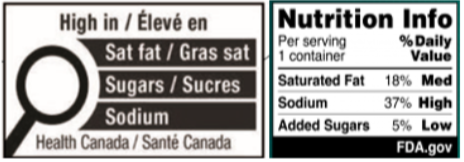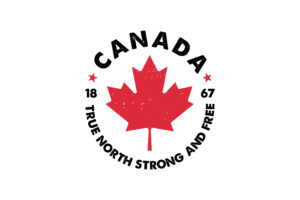Having passed the final rule updating the requirements for a food to bear the label claim “Healthy,” FDA is continuing to run full force into 2025 with a new food additive ban and a proposed nutrition label health warning marking red dye, saturated fats, added sugars, and sodium as the latest ingredients to be deemed unsafe or unhealthy in foods.
- We fully expected it to happen and now it has. On January 15, FDA revoked authorization for the use of FD&C Red No. 3, amending its color additive regulations to no longer allow the use of the dye in food and ingested drugs. The ruling follows California’s banning of the dye and 10 other states introducing legislation.
- Taking a cue from Canada (instead of the states this time), FDA also has proposed a new front-of-package nutrition label to be included on foods, not only showing the daily value percentages of saturated fat, sodium, and added sugars, but displaying if that percentage is High, Medium, or Low.
To delve further into each of these:
RED DYE NO. 3
The new Red Dye No. 3 ban is in response to a 2022 color additive petition which invoked the FD&C Act Delaney Clause that prohibits FDA from authorizing an additive if it has been found to induce cancer in humans or animals. The ban is interesting because while studies have shown cancer in male lab rats exposed to high levels of the dye, the Red No. 3-induced thyroid tumors have been deemed of limited relevance to humans by FDA, JECFA, the European Food Safety Authority (EFSA), and the Food Standards Australia New Zealand (FSANZ). The rule published in the Federal Register provides further explanation of the ban and FDA’s stance.
FDA has estimated the highest exposure for Red No. 3 from the approved uses as a color additive in conventional food, dietary supplements, and ingested drugs to be 0.25 milligrams per kilogram of bodyweight per day (mg/kg bw/day) – 210-fold margin compared against the 35.8 mg/kg bw/day at which the cancerous effects were observed in the male rats. Additionally, the way the dye causes cancer in male rats (through a rat-specific hormonal mechanism) does not occur in humans, and the carcinogenicity of Red No. 3 was not observed when tested in other animals (including female rats and either sex of mice, gerbils, or dogs).
Despite that data, the Red Dye No. 3 ban is required by law because Section 721(b)(5)(B)(i) of the FD&C Act (the “Delaney Clause”) states that a color additive shall be deemed unsafe for any use which will or may result in ingestion of an additive, if the additive is found “to induce cancer when ingested by man or animal.” Thus, courts have concluded that the Delaney Clause completely bans additives found to induce cancer in any animal and that Congress intended for the Delaney Clause to be “extraordinarily rigid,” rejecting FDA’s argument that a particular color additive should be approved because it did not pose more than a de minimis cancer risk.
Thus, as stated in the rule, the Delaney Clause prevents FDA from finding a food additive to be safe if it has been found to induce cancer when ingested by an animal, “regardless of the probability, or risk, of cancer associated with exposure to the additive or of the extent to which the experimental conditions of the animal study or the carcinogenic mode of action provide insight into the health effects of human consumption and use of the additive in question.”
Manufacturers who use FD&C Red No. 3 in food have until January 15, 2027, to reformulate products. Other countries still currently allow for certain uses of FD&C Red No. 3 (called erythrosine in other countries), but foods imported to the U.S. must comply with U.S. requirements.
FRONT-OF-PACKAGE (FOP) NUTRITION LABEL
While it is well known that high amounts of saturated fat, sodium, and added sugars are unhealthy, it is less understood just how much of each of these in food should be considered as high. FDA is working to add a piece to the solution of that puzzle with a proposed rule to require that foods be labeled – on the front of the package – with a boxed symbol detailing exactly that.
The FOP label would not only state the percentage of each, but would provide a ranking of High, Medium (“Med”), or Low for each, enabling consumers to better understand what the percentages mean.
The proposed rule is similar to a regulation previously passed by Canada requiring a “High in” FOP label for the same three ingredients, with the U.S. taking it a step further to include the percentages and adding the “Med” designation as well. Compliance with the Canadian label is due by January 1, 2026; the U.S. rule proposes a compliance date of 3 years after the final rule’s effective date for businesses with $10 million or more in annual food sales, and 4 years after the final rule’s effective date for businesses with less than $10 million in annual food sales.
Following is a comparison of the two labels, with the Canadian label on the left and the U.S. label on the right:

As we noted in our previous article, FDA has begun 2025 with a number of new rules, guidances, and notices. Whether this will continue as the new federal regime takes over is anybody’s guess, but you can rely on TAG to provide our Insights on developments, best guesses on where it all will lead, and assistance as we all weather it together.
All written content in TAG articles, newsletters, and webpages is developed and written by TAG experts, not AI. We focus on the realities and the science to bring you the most current, exacting information possible.





